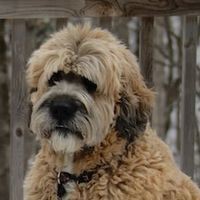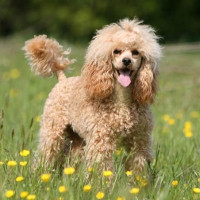 |
Doguedoodle |
|
He is not recognized by the F.C.I. |
Origin |
France -> U.S.A. | |
Translation |
Francis Vandersteen | |
This breed is also known as |
Bordeaux Doodle |
A brief presentation of the Doguedoodle |
| The Doguedoodle is a large breed that is a cross between the Dogue de Bordeaux and the Standard Poodle. The average weight of the Doguedoodle is around 44.5 kilos and it stands around 56 centimeters tall. This breed makes a good pet and an excellent watchdog, as they are courageous and loyal as well as friendly and lovable. They have a short, thick coat of rough, wavy fur that can come in many different colors, including brown, black, white, chestnut, gray, red, blue, gold or mixed. The breed is a little stubborn and can be sensitive, so training can be difficult for new owners. |
History of the Doguedoodle |
| Not much is known about the birth of the Doguedoodle, but there is documentation on the parents. The Dogue de Bordeaux and the Poodle were recently combined to create the hybrid Doguedoodle. |
A little of the Dogue de Bordeaux |
||
| The Dogue de Bordeaux, originally from France, is said to have descended from the ancient dog Molossus. It was a giant breed used in the Middle Ages for hunting, fighting and guarding property and livestock. Other giant breeds descended from the Molossus include the Tibetan Mastiff, the Great Pyrenees, the Newfoundland and the Saint Bernard. The actual history of the Dogue de Bordeaux is a mystery, as there are several stories about their past. The most common theory is that they originate from the Tibetan Mastiff, but others believe that the Dogue de Bordeaux dates back to the time when the English kings ruled Aquitaine, between the years 1203 and 1453. There are indications that this breed contributed to the development of Bulldogs and Bullmastiffs. In the 1800s, the Dogue de Bordeaux was used to bait and train jaguars and bulls, protect homes and hunt big game. The breed is well known for its large head and jaw, which are thought to have been used in the development of many large-headed breeds such as the Argentinean Mastiff and the Tosa. The Dogue de Bordeaux became popular after the 1989 film "Turner and Hooch" starring Tom Hanks. Hooch was a Dogue de Bordeaux who became the star of the show. However, the breed was only officially recognized by the American Kennel Club in 2008, where it is the 63rd favorite dog breed. | ||
 |
||
| Standard of the Dogue de Bordeaux | ||
A little of the Poodle |
||
| The Poodle originated in Germany in ancient times as a mix of French, German, Spanish, Hungarian, Portuguese and Russian water dogs. They are thought to have existed before the first century B.C. because drawings and statues of them have been found in Egyptian tombs and Roman artifacts. They were mainly used for duck hunting at first, then became popular as pets, in dog shows and for circus dogs. The AKC officially recognized the breed in 1887 and they are the 7th most popular breed in America. | ||
 |
||
| Standard of the Poodle |
Appearance of the Doguedoodle |
| The Doguedoodle varies a little according to parentage, but they mainly resemble a Poodle with a larger body and head. Their coat is also different and is generally short, thick and can be wavy or straight. They are available in many colors such as brown, black, white, gray, red, blue, gold and combinations of these. They have long, thick legs, a muscular body with a deep chest and a square head. Their ears are large and pendulous, and they have a long tail that may or may not be cropped. Their eyes are dark and round with a black or brown nose, and they may have several white spots anywhere on their body. |
Temperament of the Doguedoodle |
| Your Doguedoodle should be an excellent pet with the ability to guard your property too. They love children and other pets, but may need socializing to get along well with cats and small children under five. They are intelligent and quick learners but can be stubborn, so you'll need to be patient and consistent when training them. This breed is playful and alert and loves to have fun, but it can also be a fierce watchdog if you train it correctly. They are social animals, so you can expect them to play well at the dog park. |
Needs and activities of the Doguedoodle |
| Your Doguedoodle needs at least 45 to 60 minutes of activity a day to stay healthy and happy. A dog that doesn't get enough exercise tends to have behavioral problems such as excessive barking, whining and chewing. Some of the best activities for the Doguedoodle include fetch, flyball, Frisbee, taking him for a long walk or jog, hiking, swimming and going to the dog park. If you're unable to provide as much exercise, there are alternatives such as hiring someone to walk your dog or taking your dog to daycare once or twice a week. |
Maintenance of the Doguedoodle |
| The maintenance required for your Doguedoodle depends on your dog's coat. A Poodle's coat requires a lot of maintenance, brushing and grooming, while a Dogue de Bordeaux only needs a quick brushing every other day or so. They are sensitive to skin problems, so you should check for redness and irritation when brushing. Their paws also need special attention, as the pads tend to become dry and cracked. Your vet can recommend a moisturizing cream that you should use. Their ears need to be cleaned weekly and their nails trimmed if necessary. It's also advisable to brush your dog's teeth several times a week to avoid dental problems. |






 English (United Kingdom)
English (United Kingdom)